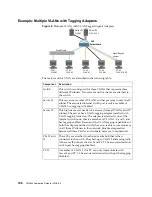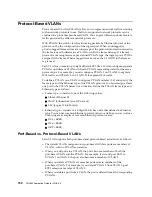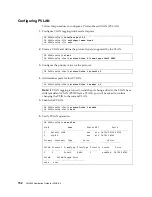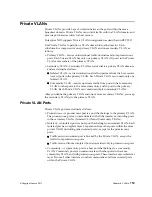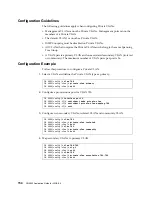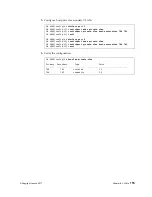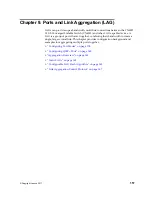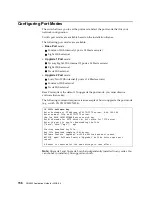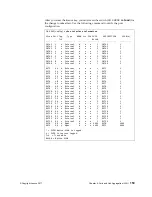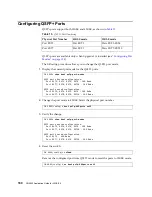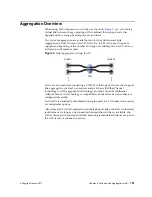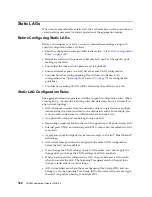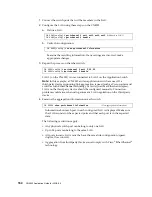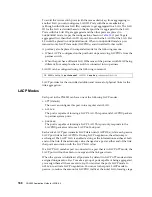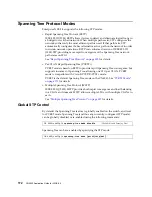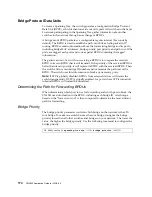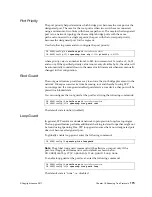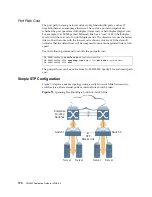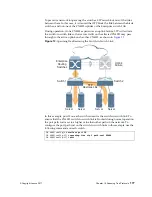
162
CN4093 Application Guide for N/OS 8.4
Static LAGs
When
you
create
and
enable
a
static
LAG,
the
LAG
members
(switch
ports)
take
on
certain
settings
necessary
for
correct
operation
of
the
aggregation
feature.
Before Configuring Static LAGs
Before
you
configure
your
LAG,
you
must
consider
these
settings,
along
with
specific
configuration
rules,
as
follows:
Read
the
configuration
rules
provided
in
the
section,
Determine
which
switch
ports
are
to
become
LAG
members
(the
specific
ports
making
up
the
LAG).
Ensure
that
the
chosen
switch
ports
are
set
to
enabled
.
Ensure
all
member
ports
in
a
LAG
have
the
same
VLAN
configuration.
Consider
how
the
existing
Spanning
Tree
will
react
to
the
new
LAG
configuration.
See
for
configuration
guidelines.
Consider
how
existing
VLANs
will
be
affected
by
the
addition
of
a
LAG.
Static LAG Configuration Rules
The
aggregation
feature
operates
according
to
specific
configuration
rules.
When
creating
LAGs,
consider
the
following
rules
that
determine
how
a
LAG
reacts
in
any
network
topology:
All
LAGs
must
originate
from
one
network
entity
(a
single
device
or
multiple
devices
acting
in
a
stack)
and
lead
to
one
destination
entity.
For
example,
you
cannot
combine
links
from
two
different
servers
into
one
LAG.
Any
physical
switch
port
can
belong
to
only
one
LAG.
Depending
on
port
availability,
the
switch
supports
up
to
24
ports
in
each
LAG.
Internal
ports
(INT
x
)
and
external
ports
(EXT
x
)
cannot
become
members
of
the
same
LAG.
Aggregation
from
third
‐
party
devices
must
comply
with
Cisco
®
EtherChannel
®
technology.
All
LAG
member
ports
must
be
assigned
to
the
same
VLAN
configuration
before
the
LAG
can
be
enabled.
If
you
change
the
VLAN
settings
of
any
LAG
member,
you
cannot
apply
the
change
until
you
change
the
VLAN
settings
of
all
LAG
members.
When
an
active
port
is
configured
in
a
LAG,
the
port
becomes
a
LAG
member
when
you
enable
the
LAG.
The
Spanning
Tree
parameters
for
the
port
then
change
to
reflect
the
new
LAG
settings.
All
LAG
members
must
be
in
the
same
Spanning
Tree
Group
(STG)
and
can
belong
to
only
one
Spanning
Tree
Group
(STG).
However
if
all
ports
are
tagged
,
then
all
LAG
ports
can
belong
to
multiple
STGs.
Summary of Contents for Flex System Fabric CN4093
Page 27: ... Copyright Lenovo 2017 27 Part 1 Getting Started ...
Page 28: ...28 CN4093 Application Guide for N OS 8 4 ...
Page 58: ...58 CN4093 Application Guide for N OS 8 4 ...
Page 72: ...72 CN4093 Application Guide for N OS 8 4 ...
Page 85: ... Copyright Lenovo 2017 85 Part 2 Securing the Switch ...
Page 86: ...86 CN4093 Application Guide for N OS 8 4 ...
Page 98: ...98 CN4093 Application Guide for N OS 8 4 ...
Page 112: ...112 CN4093 Application Guide for N OS 8 4 ...
Page 136: ...136 CN4093 Application Guide for N OS 8 4 ...
Page 156: ...156 CN4093 Application Guide for N OS 8 4 ...
Page 192: ...192 CN4093 Application Guide for N OS 8 4 ...
Page 228: ...228 CN4093 Application Guide for N OS 8 4 ...
Page 229: ... Copyright Lenovo 2017 229 Part 4 Advanced Switching Features ...
Page 230: ...230 CN4093 Application Guide for N OS 8 4 ...
Page 298: ...298 CN4093 Application Guide for N OS 8 4 ...
Page 382: ...382 CN4093 Application Guide for N OS 8 4 ...
Page 392: ...392 CN4093 Application Guide for N OS 8 4 ...
Page 416: ...416 CN4093 Application Guide for N OS 8 4 ...
Page 452: ...452 CN4093 Application Guide for N OS 8 4 ...
Page 466: ...466 CN4093 Application Guide for N OS 8 4 ...
Page 496: ...496 CN4093 Application Guide for N OS 8 4 ...
Page 508: ...508 CN4093 Application Guide for N OS 8 4 ...
Page 510: ...510 CN4093 Application Guide for N OS 8 4 ...
Page 514: ...514 CN4093 Application Guide for N OS 8 4 ...
Page 538: ...538 CN4093 Application Guide for N OS 8 4 ...
Page 539: ... Copyright Lenovo 2017 539 Part 7 Network Management ...
Page 540: ...540 CN4093 Application Guide for N OS 8 4 ...
Page 554: ...554 CN4093 Application Guide for N OS 8 4 ...
Page 576: ...576 CN4093 Application Guide for N OS 8 4 ...
Page 596: ...596 CN4093 Application Guide for N OS 8 4 ...
Page 604: ...604 CN4093 Application Guide for N OS 8 4 ...
Page 609: ... Copyright Lenovo 2017 609 Part 9 Appendices ...
Page 610: ...610 CN4093 Application Guide for N OS 8 4 ...
Page 626: ...626 CN4093 Application Guide for N OS 8 4 ...
Page 633: ......
Page 634: ...Part Number 00MY375 Printed in USA IP P N 00MY375 ...

